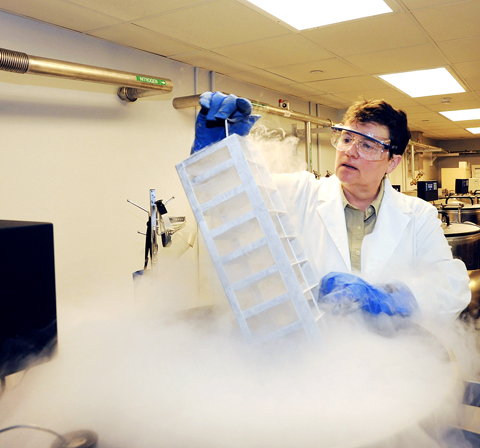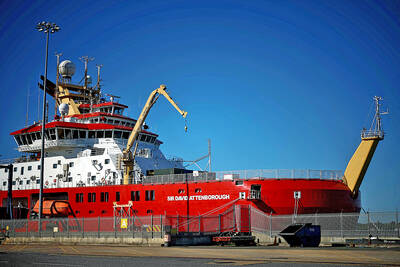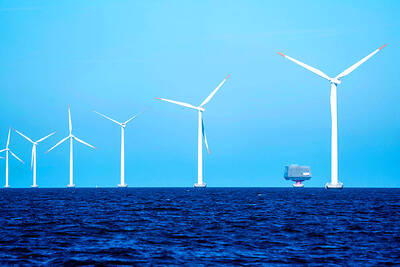It’s not your average library collection: Bits of scorpions and snakes. Tissue from jaguars. Leeches from a hippopotamus.
And on Tuesday, officials of the American Museum of Natural History and the US National Park Service signed an agreement for samples from endangered species in US parks to be added to the museum’s existing DNA collection.
The frozen samples provide researchers with genetic materials to study and help protect hundreds of species. The first new submissions will be blood samples from foxes in California’s Channel Islands National Park, followed by specimens from the American crocodile and the Hawaiian goose.

PHOTO: AP
Underground in the laboratories of the museum, which was featured in the 2006 Ben Stiller movie Night at the Museum, a half-dozen metal vats cooled with liquid nitrogen can store up to 1 million frozen tissue samples. They’re stored on racks in bar-coded boxes that are linked to a computer database so they can be located in seconds.
The park service doesn’t have such a state-of-the-art facility.
With this kind of DNA analysis it can better manage existing animal populations, using genetic relationships among the samples to trace animals’ movements on land and estimate population sizes.
The samples will provide researchers “with a uniform method to collect, analyze and store genetic material collected in parks,” acting National Park Service Director Dan Wenk said.
The lab is part of the Ambrose Monell Collection for Molecular and Microbial Research, which has allowed geneticists to use its samples for free since 2001. Researchers collect tissue samples from animals in the wilderness — an effort essential to Earth’s biodiversity at a time of massive species loss.
Wenk said the DNA samples going to the Manhattan museum are “a great asset” to the US government’s Endangered Species Act of 1973, which aims to restore all federally listed threatened and endangered species “to the point where they are again viable, self-sustaining members of their ecological communities.”
Julie Feinstein, who heads the museum’s sample collection, emphasizes that although DNA is extracted from tissue, cloning “is not part of our mission.”
The main goal, museum officials said, is preservation of species.
“Our parks are our most valuable natural area,” said George Amato, director of the museum’s Sackler Institute for Comparative Genomics, which includes the collection.
And there are many success stories, he said.
The Channel Islands National Park established a captive breeding program for foxes because of the threat from golden eagle predation.
By last year, the wild fox populations on San Miguel, Santa Rosa and the Santa Cruz Islands reached about 650, allowing the captive breeding program to be stopped.
The National Park Service sites with the most federally listed threatened and endangered species are Golden Gate National Recreation Area, the Point Reyes National Seashore and the Redwood National and State Parks, all in California; Hawaii’s Volcanoes National Park, the Haleakala National Park and Kalaupapa National Historical Park; the Canaveral National Seashore, the Everglades National Park and Biscayne National Park, all in Florida; and the Natchez Trace Parkway in Mississippi.

FRUSTRATIONS: One in seven youths in China and Indonesia are unemployed, and many in the region are stuck in low-productivity jobs, the World Bank said Young people across Asia are struggling to find good jobs, with many stuck in low-productivity work that the World Bank said could strain social stability as frustrations fuel a global wave of youth-led protests. The bank highlighted a persistent gap between younger and more experienced workers across several Asian economies in a regional economic update released yesterday, noting that one in seven young people in China and Indonesia are unemployed. The share of people now vulnerable to falling into poverty is now larger than the middle class in most countries, it said. “The employment rate is generally high, but the young struggle to

STEPPING UP: Diminished US polar science presence mean opportunities for the UK and other countries, although China or Russia might also fill that gap, a researcher said The UK’s flagship polar research vessel is to head to Antarctica next week to help advance dozens of climate change-linked science projects, as Western nations spearhead studies there while the US withdraws. The RRS Sir David Attenborough, a state-of-the-art ship named after the renowned British naturalist, would aid research on everything from “hunting underwater tsunamis” to tracking glacier melt and whale populations. Operated by the British Antarctic Survey (BAS), the country’s polar research institute, the 15,000-tonne icebreaker — boasting a helipad, and various laboratories and gadgetry — is pivotal to the UK’s efforts to assess climate change’s impact there. “The saying goes

ENERGY SHIFT: A report by Ember suggests it is possible for the world to wean off polluting sources of power, such as coal and gas, even as demand for electricity surges Worldwide solar and wind power generation has outpaced electricity demand this year, and for the first time on record, renewable energies combined generated more power than coal, a new analysis said. Global solar generation grew by a record 31 percent in the first half of the year, while wind generation grew 7.7 percent, according to the report by the energy think tank Ember, which was released after midnight yesterday. Solar and wind generation combined grew by more than 400 terawatt hours, which was more than the increase in overall global demand during the same period, it said. The findings suggest it is

TICKING CLOCK: A path to a budget agreement was still possible, the president’s office said, as a debate on reversing an increase of the pension age carries on French President Emmanuel Macron yesterday was racing to find a new prime minister within a two-day deadline after the resignation of outgoing French Prime Minister Sebastien Lecornu tipped the country deeper into political crisis. The presidency late on Wednesday said that Macron would name a new prime minister within 48 hours, indicating that the appointment would come by this evening at the latest. Lecornu told French television in an interview that he expected a new prime minister to be named — rather than early legislative elections or Macron’s resignation — to resolve the crisis. The developments were the latest twists in three tumultuous